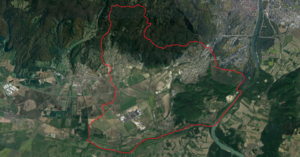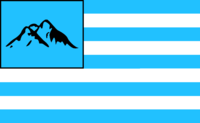Carpathian Republic
Carpathian Republic Karpatská Republika (Slovak) | |
|---|---|
|
Flag | |
 | |
| Capital and largest city | Dúbravka |
| Official languages | Slovak |
| Religion (2021) | Christianity |
| Demonym(s) | Carpathian |
| Government | Parliamentary republic |
| Legislature | Parliament |
| Establishment | |
| Area | |
• Total | 86.77 km2 (33.50 sq mi) (189) |
| Population | |
• 2021 census | 72,006 |
• Density | 830/km2 (2,149.7/sq mi) |
| GDP (nominal) | 2022 estimate |
• Total | ▲ $2,79 billion |
| HDI (2019) | ▲ 0.860 very high |
| Currency | Euro (€) (EUR) |
| Time zone | UTC+1 (CET) |
| Date format | d. m. yyy |
| Driving side | right |
| Calling code | +422 |
| Internet TLD | .cp |
The Carpathian Republic, or Carpathia, is an idea for a new country independent from Slovakia. The area is composed of the majority of Bratislava district IV. except Karlova Ves, with the addition of Marianka. Because of several border adjustments, the borders of the Bratislava IV. district and Marianka don't exactly match the potential Carpathian border. Carpathia would be smaller than the current district borders, with 2,135,000 m2 ceded to Slovakia.
The total area of the Carpathian Republic would be 86.77 km2 and the population would be 72,006 people (2021).
The republic would contain 6 cities, previously districts of Bratislava + Marianka. The capital and the largest city by population would be Dúbravka with over 36,000 residents.
Each city and its population:
- Dúbravka - 36,024
- Devínska Nová Ves - 17,117
- Lamač - 7,761
- Záhorská Bystrica - 6,880
- Marianka - 2,272
- Devín - 1,952
Economy & Industry
Carpathia's economy would largely stand on a single Volkswagen factory in the north-west, which is currently the largest private employer in Slovakia. If Carpathia became a country, and would be a part of the Shenghen area or the EEA, thousands of workers in the factory would travel between Slovakia and Carpathia every day. This situation, combined with the very small size and population of Carpahia, would result in an economic boom and Carpathia's economy would be comparable to many european microstates such as Luxembourg or Liechtenstein. It would boost the Carpathian GDP per capita, possibly reaching beyond 100,000€.
The main focus of the Carpathian government would be to improve public infrastructure and social policies. The Human Development Index may grow by about 10% within 10 years, hopefully reaching around 0,920.
Infrastructure
Roads
The D2 highway currently passes through the future land of Carpathia. It connects the Slovak capital Bratislava with the Czech Republic in the north and several major cities. It would be optimal if Carpathia became part of the Shenghen area right after its creation to avoid passport controls on its frequented borders with Slovakia.
There is a Slovak plan to extend the D4 highway, encircling Bratislava from the east all the way to Stupava or Marianka via a 10 km tunnel under the Little Carpathians, so it would connect to D2 in Carpathia or just outside of its borders, maybe a special shared zone or condominium would have to be created around the interchange. Either way, this would allow the extension of the D4 highway from Carpathia into Austria via a new bridge on the Morava river, which would later connect to the Austrian highway system. As a result, Carpathia would be well connected to both the Czech Republic and Austria.
A new road will have to be constructed between Carpathia's capital Dúbravka to the city of Devín on the other side of the Devínska Kobyla massif because the only road which currently connects the cities is through Devínska Nová Ves. This road is very long and inconvenient. This new connection would strategicaly connect the capital directly to the river Danube.
Rail
Currently, there are several railway stations in the area, most importantly in the capital Dúbravka, and the cities of Lamač and Devínska Nová Ves. The railway then continues into Austria via the Marcheggský viadukt in the north-west and Slovakia a little further out. The Volkswagen factory is also connected to the rest of the rail network.
Additional extension of the railway into Záhorská Bystrica would be required, possibly even into Marianka.
Underground Metro system would not be constructed as even the capital is too small. Trams are currently operating in Dúbravka, continuing into Bratislava. There are currently plans to extend the current tram network to some parts of Devínska Nová Ves, proposed by the city of Bratislava. In Carpathia, it would be extended all the way to Záhorská Bystrica.
Air
There are currently no airports or airfields in the area, neither are there any serious plans to construct any. It is however possible that a small airfield may be constructed in the empty fields west of the D2 highway.
Bike
In the north-west, next to the river Morava, called Devínske Alúvium Moravy. There is a scenic bike path along the river stretching from Devínska Nová Ves to the north with a total lenght of 6,7 km until it reaches the Slovak border*. The area even has its own train station. The nature in the area is currently not protected, but it would certainly become a national park in Carpathia.
Bike infrastructure in the 6 cities is very limited and new cycle paths would have to be built. For example, there is currently no way to travel between the capital Dúbravka and the 2nd largest city Devínska Nová Ves by bike, or even by foot. It would be a priority to construct cycle paths connecting all 6 cities.
